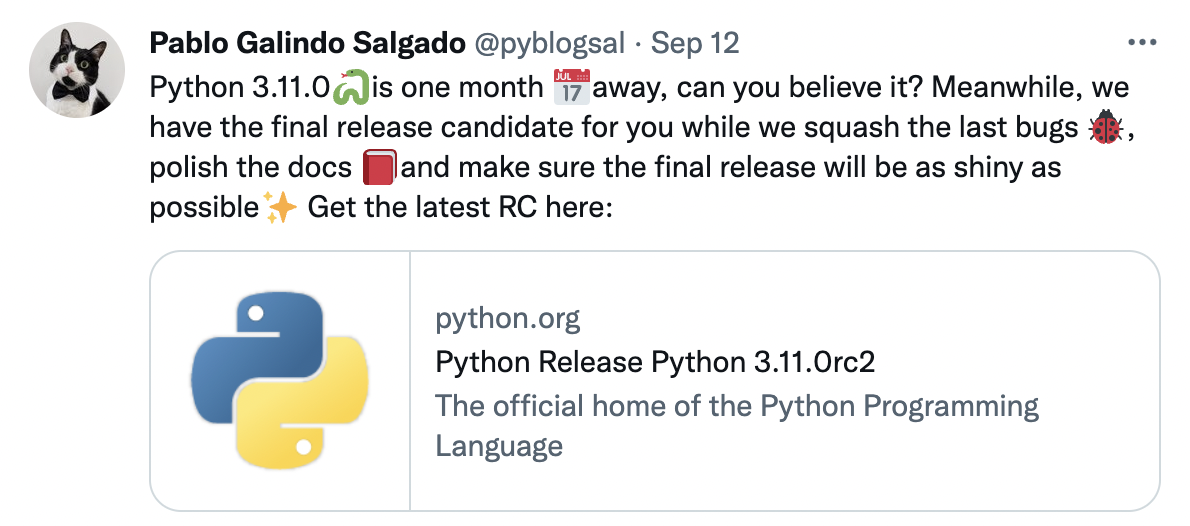In September 2022, the Python 3.11.0rc2 release candidate version became available for you to test and stay on top of Python’s latest features. This release is the last preview version before the final release of Python 3.11.0, which is scheduled for October 24, 2022.
Python’s latest bugfix versions, including 3.10.7, have introduced breaking changes to cope with a security vulnerability that affects the str to int conversion and can leave you open to DDoS attacks.
As usual, the Python ecosystem has celebrated the release of new versions of many fundamental packages, libraries, and frameworks.
Let’s dive into the most exciting Python news from the past month!
Join Now: Click here to join the Real Python Newsletter and you’ll never miss another Python tutorial, course, or news update.
Python 3.11.0rc2 Was Released
Every month, Python releases several versions from its different development branches. New releases typically add new features, fix bugs, correct security vulnerabilities, and more. September 2022 brought several new releases for Python programmers to test, use, and enjoy. Most notable was Python’s last 3.11 release candidate.
Python 3.11.0rc2 was released on Monday, September 12, 2022. This is the last preview version before the final release of Python 3.11.0:

Only reviewed changes that fix bugs are allowed during the release candidate phase. There will be very few, if any, code changes between this release candidate and the final release. As listed in the release post, the new features of the 3.11 series, as compared to 3.10, include the following:
- PEP 657 – Include Fine-Grained Error Locations in Tracebacks
- PEP 654 – Exception Groups and
except* - PEP 680 –
tomllib: Support for Parsing TOML in the Standard Library - PEP 673 –
SelfType - PEP 646 – Variadic Generics
- PEP 675 – Arbitrary Literal String Type
- PEP 655 – Marking individual
TypedDictitems as required or potentially-missing - PEP 681 – Data Class Transforms
Python 3.11 also comes with a couple of other exciting updates. gh-90908 introduces task groups to asyncio, and gh-34627 allows for atomic grouping ((?>…)) and possessive quantifiers (*+, ++, ?+, {m,n}+) in regular expressions.
Plus, Python 3.11 is going to deliver faster performance:
The Faster CPython Project is already yielding some exciting results. Python 3.11 is up to 10-60% faster than Python 3.10. On average, we measured a 1.22x speedup on the standard benchmark suite. See Faster CPython for details. (Source)
To dive deeper into some of these cool new features of Python 3.11, check out the following resources depending on your specific needs and interests:
- Python 3.11 Preview: Even Better Error Messages
- Python 3.11 Preview: Task and Exception Groups
- Python 3.11 Preview: TOML and tomllib
- Python and TOML: New Best Friends
The first three tutorials in this list are part of a series of articles to help you get up and running with Python 3.11.
If you want to install this new release and try out some of its most exciting features, then check out the Real Python guide called How Can You Install a Pre-Release Version of Python?
Python 3.11.0 Release Was Postponed Until October 24
The Python core development team postponed the final release of Python 3.11.0 due to a week’s delay in the last release candidate, 3.11.0rc2. Now the official release is scheduled for Monday, October 24, 2022.
This final release was initially scheduled for Monday, October 3, 2022. So, we’ll have to wait three more weeks to welcome Python 3.11.0 onto our computers.
According to the 3.11 lifespan notes, this release will receive bugfix updates approximately every two months for about eighteen months.
Python Introduced a Breaking Change to Fix a Vulnerability
Python releases 3.10.7, 3.9.14, 3.8.14, and 3.7.14 are now available. Python 3.10, the latest stable version, released its seventh bugfix version out of schedule. This decision aimed to address a vulnerability that would allow denial of service (DoS) attacks due to the algorithmic complexity of str to int conversions.
The CVE platform registered this publicly disclosed cybersecurity vulnerability in its CVE-2020-10735 report. The original vulnerability description states:
A flaw was found in Python. In algorithms with quadratic time complexity using non-binary bases, when using
int("text"), a system could take 50ms to parse anintstring with 100,000 digits and 5s for 1,000,000 digits (float,decimal,int.from_bytes(), andint()for binary bases 2, 4, 8, 16, and 32 are not affected). The highest threat from this vulnerability is to system availability. (Source)
Meanwhile, the What’s New In Python 3.10 page in the Python documentation describes the issue as follows:
Converting between
intandstrin bases other than 2 (binary), 4, 8 (octal), 16 (hexadecimal), or 32 such as base 10 (decimal) now raises aValueErrorif the number of digits in string form is above a limit to avoid potential denial of service attacks due to the algorithmic complexity. (Source)
This change will break existing code that runs this type of conversion on numbers that exceed a given number of digits. The default limit for the number of digits is now 4300 digits. Here’s a short example that uncovers the breaking change by running a str to int conversion in Python 3.10.6 vs 3.10.7:
>>> # Python 3.10.6
>>> int("2" * 5432)
222222222222222222222222222222222222222222222222222222222222222...
>>> # Python 3.10.7
>>> int("2" * 5432)
Traceback (most recent call last):
...
ValueError: Exceeds the limit (4300) for integer string conversion:
value has 5432 digits; use sys.set_int_max_str_digits()
to increase the limit.
This call to int() works fine in Python 3.10.6 and raises a ValueError in Python 3.10.7. Note that Python can still work with large integers. The error is only raised when converting between integers and strings. This new behavior could break more than one codebase out there, so keep an eye on it if your code usually deals with this kind of conversion.
Fortunately, you can increase the limit for the allowed number of digits when you expect an operation to exceed it. To do this, you can use one of the following:
- The
PYTHONINTMAXSTRDIGITSenvironment variable - The
-X int_max_str_digitscommand-line flag - The
set_int_max_str_digits()function from thesysmodule
Check the documentation for more details on changing the default limit if you expect your code to exceed this value.
Finally, the 3.9.14, 3.8.14, and 3.7.14 security releases also address the described issue, along with some less urgent security improvements and fixes. So, upgrading your installation is highly recommended if you’re using any of these Python series in production code.
New Releases in the Python Ecosystem
The global Python community never stops pushing the Python ecosystem into the future. As usual, you’ll find plenty of new releases from different libraries, frameworks, and projects. Django, pandas, TensorFlow, and Matplotlib are some of the most visible projects in September’s list of new releases.
Django Bugfix Release 4.1.1
On September 5, 2022, Django issued its 4.1.1 bugfix release. This release fixes several regressions from Django 4.1. For a complete fix list, check out this version’s release notes.
As usual, you can download the released package from Django’s downloads page. Alternatively, you can install Django directly from the Python package index, PyPI, by running pip install Django on your command line or terminal.
pandas 1.5.0 Was Released
The pandas library, another Python heavyweight , released a new version on September 19. pandas 1.5.0 is now available with several enhancements and bug fixes.
Some of the most relevant enhancements include:
- The pandas development team now supports
pandas-stubs, which provides type stubs for the pandas API. These type stubs allow you to type check your pandas code using mypy and Pyright. - The
DataFrameinterchange API protocol is now available for use. The purpose of this protocol is to enable data interchange between different types of DataFrames. It allows you to convert one type of DataFrame into another type. - The
Stylerclass now has a new.concat()method, which allows adding customized footer rows to visualize additional calculations on the data.
Check out the release notes of this pandas version for a complete list of new features, bug fixes, and more.
TensorFlow 2.10 Was Released
TensorFlow 2.10 was released on September 6, 2022! This release includes several new user-friendly features in the Keras deep learning Python API. You’ll find features that help you develop transformer-style models. You’ll also have deterministic and stateless Keras initializers, enabling Keras to support new features such as multi-client model training with DTensor.
The release also brings updates to the Keras optimizers API. This change shouldn’t affect too many users, but you should check the documentation to verify if any API that you use in your workflow has changed.
You’ll also find new tools to help you load audio data and generate audio classification datasets from directories of WAV files. With these new tools, you can generate labeled tf.data.Dataset objects that you can use to build and train automatic speech recognition (ASR) models.
For a complete list of new features and improvements in TensorFlow 2.10, take a look at the release post, What’s new in TensorFlow 2.10?
Matplotlib 3.6.0 Was Released
The latest release of Matplotlib brings several cool new features that’ll help you create better plots from your data. The most significant improvements reach many aspects of the library, including:
- Figure and axes creation and management
- Plotting methods
- Colors and colormaps
- Titles, ticks, and labels
- Legends
- Markers
- Fonts and text
- 3D axes
- Interactive tools
The release also includes platform-specific changes that improve several aspects of Matplotlib’s behavior on the macOS and Windows platforms.
Again, if you want a detailed list of new features and enhancements, check the release notes in What’s new in Matplotlib 3.6.0 (Sep 15, 2022).
If you’d like to build and flex your Matplotlib muscles, you can draw the Mandelbrot set or use plt.scatter() to visualize your data. If you want to customize your plots and graphs with a single line of code, then check out The Real Python Podcast: Episode 125 to learn how to work with style sheets.
What’s Next for Python?
So, what’s your favorite piece of Python news from September? Did we miss anything notable? Are you going to give Python 3.11.0rc2 a try? What do you think about the breaking changes around the str to int conversion in Python 3.10.7? Let us know in the comments!
Happy Pythoning!
Join Now: Click here to join the Real Python Newsletter and you’ll never miss another Python tutorial, course, or news update.








